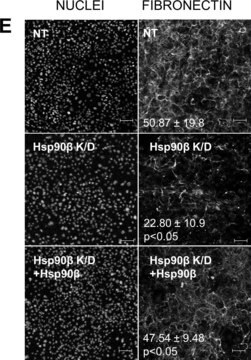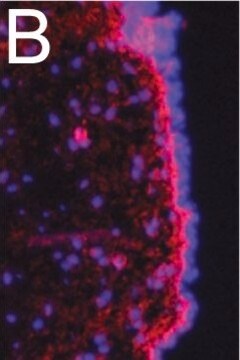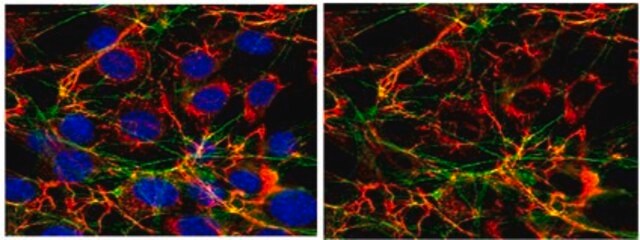推薦產品
產品名稱
Anti-Fibronectin antibody, Mouse monoclonal, clone IST-3, purified from hybridoma cell culture
抗體表格
purified from hybridoma cell culture
品質等級
無性繁殖
IST-3
形狀
liquid
物種活性
sheep, chicken, human, bovine, goat, dog, rabbit
濃度
~1 mg/mL
技術
immunofluorescence: 2.5-5 μg/mL using human foreskin fibroblast Hs68 cells
同型
IgG1
UniProt登錄號
運輸包裝
dry ice
儲存溫度
−20°C
目標翻譯後修改
unmodified
一般說明
Two types of Fibronectin are present in vertebrates: soluble plasma Fibronectin and insoluble cellular Fibronectin. The plasma form of Fibronectin (formerly known as cold-insoluble globulin or CIG) is synthesized by hepatocytes, secreted to blood and upon tissue injury, is incorporated into fibrin clots effecting platelet function and mediating hemostasis.8 Cellular Fibronectin is synthesized by many cell types, including fibroblasts, endothelial cells, chondrocytes, synovial cells and myocytes. It is assembled by cells as they migrate into the clot to reconstitute damaged tissue.
特異性
Monoclonal Anti-Fibronectin antibody specifically recognizes epitope located within the fourth type-three repeat of human plasma fibronectin. The antibody localizes plasma and cellular fibronectin both in its natural and denatured-reduced forms. The product reacts with fibronectin from human, goat, bovine4, porcine5, mouse6, rat7, dog and chicken origin.
應用
The antibody may be used in various immunochemical techniques including Immunoblotting1, ELISA, RIA1-2, Immunofluorescence3 and Immunohistochemistry4.
生化/生理作用
Fibronectin (FN) is a multi-domain glycoprotein composed of two nearly identical disulfide-bound polypeptides with molecular weights of 220-240 KDa. It is a ubiquitous and essential component of the extracellular matrix (ECM) which plays a vital role during tissue repair. Fibronectin functions both as a regulator of cellular processes and as an important scaffolding protein to maintain and direct tissue organization and ECM composition. It is widely expressed by multiple cell types and is critically important in vertebrate development, as demonstrated by the early embryonic lethality of mice with targeted inactivation of the FN gene. Fibronectin is suggested to enhance cell adhesion and spreading and to affect the routes of cell migration both in vivo and in culture.11 It has been shown that upon malignant transformation many cells lose their surface bound fibronectin.
外觀
Supplied as a solution in 0.01 M phosphate buffered saline pH 7.4, containing 15 mM sodium azide as a preservative.
儲存和穩定性
For continuous use, store at 2-8°C for up to one month. For extended storage, freeze in working aliquots. Repeated freezing and thawing is not recommended. If slight turbidity occurs upon prolonged storage, clarify the solution by centrifugation before use. Working dilution samples should be discarded if not used within 12 hours.
免責聲明
Unless otherwise stated in our catalog our products are intended for research use only and are not to be used for any other purpose, which includes but is not limited to, unauthorized commercial uses, in vitro diagnostic uses, ex vivo or in vivo therapeutic uses or any type of consumption or application to humans or animals.
儲存類別代碼
12 - Non Combustible Liquids
水污染物質分類(WGK)
nwg
閃點(°F)
Not applicable
閃點(°C)
Not applicable
Xinglong Zheng et al.
The Journal of biological chemistry, 278(32), 30136-30141 (2003-06-07)
ADAMTS13 consists of a reprolysin-type metalloprotease domain followed by a disintegrin domain, a thrombospondin type 1 motif (TSP1), Cys-rich and spacer domains, seven more TSP1 motifs, and two CUB domains. ADAMTS13 limits platelet accumulation in microvascular thrombi by cleaving the
H J Simonsz et al.
Documenta ophthalmologica. Advances in ophthalmology, 52(3-4), 409-414 (1982-01-29)
A patient is described with an orbital fistula complicating frontal sinusitis and osteomyelitis of the frontal bone. The fistula was excised, but a fortnight later an acute exacerbation occurred. From the discharging pus a Staphylococcus aureus was cultured and from
Anna Tsapara et al.
Molecular biology of the cell, 21(6), 860-870 (2010-01-22)
Maintenance of the epithelial phenotype is crucial for tissue homeostasis. In the retina, dedifferentiation and loss of integrity of the retinal pigment epithelium (RPE) leads to retinal dysfunction and fibrosis. Transforming growth factor (TGF)-beta critically contributes to RPE dedifferentiation and
Wing S To et al.
Fibrogenesis & tissue repair, 4, 21-21 (2011-09-20)
Fibronectin (FN) is a ubiquitous extracellular matrix (ECM) glycoprotein that plays vital roles during tissue repair. The plasma form of FN circulates in the blood, and upon tissue injury, is incorporated into fibrin clots to exert effects on platelet function
我們的科學家團隊在所有研究領域都有豐富的經驗,包括生命科學、材料科學、化學合成、色譜、分析等.
聯絡技術服務








